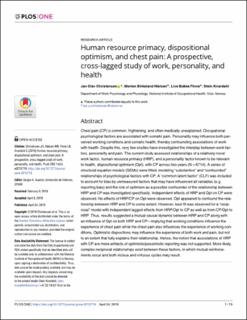| dc.description.abstract | Chest pain (CP) is common, frightening, and often medically unexplained. Occupational psychological factors are associated with somatic pain. Personality may influence both perceived working conditions and somatic health, thereby confounding associations of work with health. Despite this, very few studies have investigated the interplay between work factors, personality and pain. The current study assessed relationships of a relatively novel work factor, human resource primacy (HRP), and a personality factor known to be relevant to health, dispositional optimism (Opt), with CP across two years (N = 6714). A series of structural equation models (SEMs) were fitted, modeling “substantive” and “confounded” relationships of psychological factors with CP. A “common latent factor” (CLF) was included to account for bias by unmeasured factors that may have influenced all variables (e.g. reporting bias) and the role of optimism as a possible confounder of the relationship between HRP and CP was investigated specifically. Independent effects of HRP and Opt on CP were observed. No effects of HRP/CP on Opt were observed. Opt appeared to confound the relationship between HRP and CP to some extent. However, best fit was observed for a “reciprocal” model with independent lagged effects from HRP/Opt to CP as well as from CP/Opt to HRP. Thus, results suggested a mutual causal dynamic between HRP and CP along with an influence of Opt on both HRP and CP—implying that working conditions influence the experience of chest pain while the chest pain also influences the experience of working conditions. Optimistic dispositions may influence the experience of both work and pain, but not to an extent that fully explains their relationship. Hence, the notion that associations of HRP with CP are mere artifacts of optimistic/pessimistic reporting was not supported. More likely, complex reciprocal relationships exist between these factors, in which mutual reinforcements occur and both vicious and virtuous cycles may result. | |
